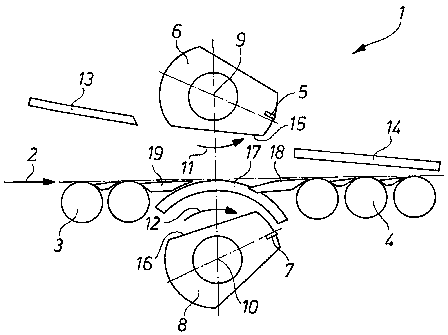Some of the information on this Web page has been provided by external sources. The Government of Canada is not responsible for the accuracy, reliability or currency of the information supplied by external sources. Users wishing to rely upon this information should consult directly with the source of the information. Content provided by external sources is not subject to official languages, privacy and accessibility requirements.
Any discrepancies in the text and image of the Claims and Abstract are due to differing posting times. Text of the Claims and Abstract are posted:
| (12) Patent: | (11) CA 2526092 |
|---|---|
| (54) English Title: | DEVICE FOR TRANSVERSALLY CUTTING A ROLLED STRIP |
| (54) French Title: | DISPOSITIF DE CISAILLAGE A COUPE TRANSVERSALE D'UNE BANDE DE LAMINAGE |
| Status: | Granted and Issued |
| (51) International Patent Classification (IPC): |
|
|---|---|
| (72) Inventors : |
|
| (73) Owners : |
|
| (71) Applicants : |
|
| (74) Agent: | RICHES, MCKENZIE & HERBERT LLP |
| (74) Associate agent: | |
| (45) Issued: | 2010-09-07 |
| (86) PCT Filing Date: | 2004-05-25 |
| (87) Open to Public Inspection: | 2004-12-23 |
| Examination requested: | 2009-02-27 |
| Availability of licence: | N/A |
| Dedicated to the Public: | N/A |
| (25) Language of filing: | English |
| Patent Cooperation Treaty (PCT): | Yes |
|---|---|
| (86) PCT Filing Number: | PCT/EP2004/005582 |
| (87) International Publication Number: | WO 2004110688 |
| (85) National Entry: | 2005-11-16 |
| (30) Application Priority Data: | ||||||
|---|---|---|---|---|---|---|
|
The invention relates to a device for transversally cutting a rolled strip
using shears, especially drum shears. According to the invention, a gap
between the end of the roller table upstream of the shears and the beginning
of the roller table downstream of the shears, where there is no support for
the rolled strip, is reduced by a pivotable roller table part supporting the
rolled strip as it passes through, and a mobile guiding table is arranged
between said pivotable roller table part and the beginning of the rear roller
table.
L'invention concerne un dispositif de cisaillage à coupe transversale d'une bande de laminage à l'aide d'une cisaille, notamment d'un tambour cisaille. Un vide situé entre la fin du train de rouleaux en amont de la cisaille et le début du train de rouleaux en aval de la cisaille, la bande de laminage n'ayant aucun support, est réduit par une partie rotative du train de rouleaux supportant la bande de laminage lors de son défilement. Un plateau de guidage mobile est placé entre une partie rotative de train de rouleaux et le début du train de rouleaux arrière.
Note: Claims are shown in the official language in which they were submitted.
Note: Descriptions are shown in the official language in which they were submitted.

2024-08-01:As part of the Next Generation Patents (NGP) transition, the Canadian Patents Database (CPD) now contains a more detailed Event History, which replicates the Event Log of our new back-office solution.
Please note that "Inactive:" events refers to events no longer in use in our new back-office solution.
For a clearer understanding of the status of the application/patent presented on this page, the site Disclaimer , as well as the definitions for Patent , Event History , Maintenance Fee and Payment History should be consulted.
| Description | Date |
|---|---|
| Common Representative Appointed | 2019-10-30 |
| Common Representative Appointed | 2019-10-30 |
| Grant by Issuance | 2010-09-07 |
| Inactive: Cover page published | 2010-09-06 |
| Inactive: Final fee received | 2010-06-18 |
| Pre-grant | 2010-06-18 |
| Notice of Allowance is Issued | 2010-06-01 |
| Letter Sent | 2010-06-01 |
| Notice of Allowance is Issued | 2010-06-01 |
| Inactive: Approved for allowance (AFA) | 2010-05-17 |
| Letter Sent | 2009-10-26 |
| Letter Sent | 2009-04-02 |
| Amendment Received - Voluntary Amendment | 2009-03-03 |
| Request for Examination Requirements Determined Compliant | 2009-02-27 |
| All Requirements for Examination Determined Compliant | 2009-02-27 |
| Request for Examination Received | 2009-02-27 |
| Letter Sent | 2006-03-21 |
| Inactive: Single transfer | 2006-02-16 |
| Inactive: Cover page published | 2006-01-25 |
| Inactive: Courtesy letter - Evidence | 2006-01-24 |
| Inactive: Notice - National entry - No RFE | 2006-01-23 |
| Application Received - PCT | 2005-12-19 |
| National Entry Requirements Determined Compliant | 2005-11-16 |
| Application Published (Open to Public Inspection) | 2004-12-23 |
There is no abandonment history.
The last payment was received on 2010-04-29
Note : If the full payment has not been received on or before the date indicated, a further fee may be required which may be one of the following
Please refer to the CIPO Patent Fees web page to see all current fee amounts.
Note: Records showing the ownership history in alphabetical order.
| Current Owners on Record |
|---|
| SMS SIEMAG AKTIENGESELLSCHAFT |
| Past Owners on Record |
|---|
| JUERGEN MERZ |
| KLAUS BAEUMER |